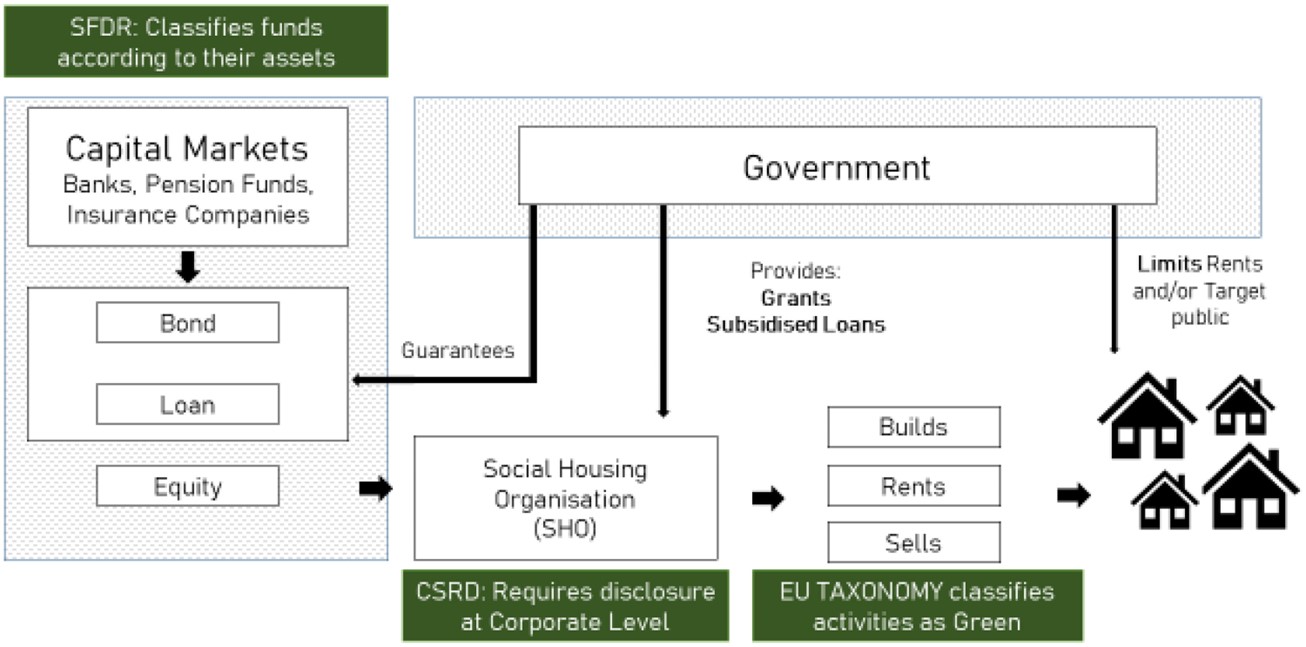Area: Policy and financing
The shift from ‘government’ to ‘governance’ has been debated since the early 1970s. Whilst state interventionism had been widely embraced within western societies during the post-war decades, governments gradually moved from exercising constitutional powers to acting as facilitators and cooperative partners (Rhodes, 1997). Over the course of a few decades, this resulted in governance as ‘interactive social-political forms of governing’ (Nag, 2018, p. 124). Hira and Cohn (2003, p. 12), influenced by Keohane (2002), define governance as “the processes and institutions, both formal and informal, that guide and restrain the collective activities of a group”. Its decentralised and flexible nature could still include public actors but would also leave space for private and third-sector parties to provide services in hybrid and temporary institutional arrangements.
To formulate one single definition of ‘housing governance’ as a particular mode of governance is however difficult due to its multilevel character. Housing could relate to either a family home, a housing association, or a complete local/national housing governance framework. On a household level, Wotschack (2005, p. 2) defines governance as managing “the daily time allocation of spouses by household rules and conflict handling strategies”. The work of Wijburg (2021) indicates that local/municipal governance entails a set of public interventions, strategies, policies and provisions used to provide local needs (e.g. housing supply). On the national level, Yan et al. (2021) define public rental housing (PRH) governance as “a structure of a wide range of government and non-governmental actors that act in all its phases of PRH provision from policy design to implementation and realisation”.[1] This specific definition on PRH combines the domestic definition of governance with Wijburg’s understanding of governance on the local level. Within the Chinese context, the national government provides policies and creates nationwide operational methods, whilst local governments implement and formulate the policies locally (Yan et al., 2021).
Critics point out that a more decentralised governance structure complicates the public accountability of housing provision. Peters and Pierre (2006, p. 40) distinguish problems concerning the ‘isolation’ and ‘enforcement’ of accountability. The former refers to demarcation, as it is easier to measure the performance of a government housing agency directly responsible for new build and operations, than those from the private sector in an indirect role trying to stimulate and facilitate other actors and contracting out construction and operations (Shamsul Haque, 2000). The latter relates to the accountability deficit that arises when responsibility is transferred from democratically governed municipal agencies to actors without a representative institutional arrangement, and thus without control mechanisms for tenants or the wider population (Mullins, 2006).
Throughout history, understanding of governing has evolved together with the role of government. The state plays a different role in capitalism, corporatism and socialism, which has varying effects on local and/or (inter)national levels. Whilst the above paragraphs describe housing governance within a democratic governance regime, transferring the conceptual debate to autocratic or hybrid regimes would pose difficulties. Thus, finding a unique definition of housing governance applicable in all spheres remains a challenge, and the specific context must be carefully considered. Important challenges remain, and as housing provision mechanisms evolve, further exploration of housing governance, especially on a municipal level, are likely to gain importance (Hoekstra, 2020).
[1] “Housing provision is a physical process of creating and transferring a dwelling to its occupiers, its subsequent use and physical reproduction and at the same time, a social process dominated by the economic interests involved” ibid.
References
Hira, A., & Cohn, T. H. (2003). Toward a Theory of Global Regime Governance. International Journal of Political Economy, 33(4), 4-27.
Hoekstra, J. (2020). Comparing Local Instead of National Housing Regimes? Towards International Comparative Housing Research 2.0. Critical Housing Analysis, 7(1), 74-85. https://doi.org/10.13060/23362839.2020.7.1.505
Keohane, R. O. (2002). Power and governance in a partially globalized world. Routledge.
Mullins, D. (2006). Competing Institutional Logics? Local Accountability and Scale and Efficiency in an Expanding Non-Profit Housing Sector. Public Policy and Administration, 21(3), 6-24.
Nag, N. S. (2018). Government, Governance and Good Governance. Indian Journal of Public Administration, 64(1), 122-130. https://doi.org/doi:10.1177/0019556117735448
Peters, B. G., & Pierre, J. (2006). Governance, accountability and democratic legitimacy. In A. Benz & Y. Papadopoulos (Eds.), Governance and Democracy: Comparing National, European and International Experiences (pp. 29-43). Routledge.
Rhodes, R. A. W. (1997). Understanding governance: policy networks, governance, reflexivity and accountability. Open University Press.
Shamsul Haque, M. (2000). Significance of Accountability under the New Approach to Public Governance. International Review of Administrative Sciences, 66(4), 599-617. https://doi.org/10.1177/0020852300664004
Wijburg, G. (2021). The governance of affordable housing in post-crisis Amsterdam and Miami. Geoforum, 119, 30-42. https://doi.org/10.1016/j.geoforum.2020.12.013
Wotschack, P. (2005). Household governance and time allocation: structures and processes of social control in Dutch households.
Yan, J., Haffner, M., & Elsinga, M. (2021). Inclusionary Housing: An Evaluation of a New Public Rental Housing Governance Instrument in China. Land, 10(3). https://doi.org/10.3390/land10030305
Created on 16-02-2022 | Update on 23-10-2024
Related definitions
Housing Regime
Area: Policy and financing
Created on 24-02-2022 | Update on 23-10-2024
Read more ->Just Transition
Area: Policy and financing
Created on 03-06-2022 | Update on 23-10-2024
Read more ->Social Sustainability
Area: Community participation
Created on 03-06-2022 | Update on 23-10-2024
Read more ->Social Housing
Area: Policy and financing
Created on 17-06-2023 | Update on 23-10-2024
Read more ->Path Dependence
Area: Policy and financing
Created on 31-08-2023 | Update on 23-10-2024
Read more ->Collaborative Governance
Area: Community participation
Created on 26-10-2023 | Update on 23-10-2024
Read more ->Deliberative Democracy
Area: Community participation
Created on 19-06-2024 | Update on 23-10-2024
Read more ->Related cases

Housing Fund of the Republic of Slovenia
Created on 04-07-2023

ESG finance and social housing decarbonisation
Created on 05-02-2024


